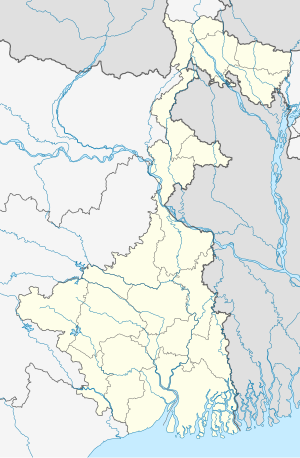Benjanhari Acharial
Benjanhari Acharial | |
|---|---|
Census Town | |
| Coordinates: 22°27′56″N 88°10′28″E / 22.4656°N 88.1744°E | |
| Country | |
| State | |
| District | South 24 Parganas |
| CD block | Budge Budge I |
| Area | |
| • Total | 1.07 km2 (0.41 sq mi) |
| Elevation | 9 m (30 ft) |
| Population (2011) | |
| • Total | 5,187 |
| • Density | 4,800/km2 (13,000/sq mi) |
| Languages | |
| • Official | Bengali[1][2] |
| • Additional official | English[1] |
| Time zone | UTC+5:30 (IST) |
| PIN | 700137 |
| Telephone code | +91 33 |
| Vehicle registration | WB-19 to WB-22, WB-95 to WB-99 |
| Lok Sabha constituency | Diamond Harbour |
| Vidhan Sabha constituency | Budge Budge |
| Website | www |
Benjanhari Acharial is a census town within the jurisdiction of the Budge Budge police station in the Budge Budge I CD block in the Alipore Sadar subdivision of the South 24 Parganas district in the Indian state of West Bengal.
Geography
M: municipal city/ town, CT: census town, R: rural/ urban centre,
Owing to space constraints in the small map, the actual locations in a larger map may vary slightly
Bakrahat is in Bishnupur II CD block, but Lakshmibala Rural Hospital at Bakrahat serves Budge Budge II CD block and so it is included here.
Area overview
Alipore Sadar subdivision is the most urbanized part of the South 24 Parganas district. 59.85% of the population lives in the urban areas and 40.15% lives in the rural areas. In the northern portion of the subdivision (shown in the map alongside) there are 21 census towns. The entire district is situated in the Ganges Delta and the subdivision, on the east bank of the Hooghly River, is an alluvial stretch, with industrial development.[3][4][5]
Note: The map alongside presents some of the notable locations in the subdivision. All places marked in the map are linked in the larger full screen map.
Location
Benjanhari Acharial is located at 22°27′56″N 88°10′28″E / 22.4656°N 88.1744°E. It has an average elevation of 9 metres (30 ft).
Balarampur, Uttar Raypur, Buita, Benjanhari Acharial, Abhirampur and Nischintapur form a cluster of census towns around Budge Budge and Pujali, as per the map of the Budge Budge I CD block on page 167 of the District Census Handbook 2011 for the South 24 Parganas.[6]
Demographics
According to the 2011 Census of India, Benjanhar Acharial had a total population of 5,187, of which 2,609 (50%) were males and 2,578 (50%) were females. There were 489 people in the age range of 0 to 6 years. The total number of literate people was 3,720 (79.18% of the population over 6 years).[7]
Infrastructure
According to the District Census Handbook 2011, Benjanhari Acharial covered an area of 1.0712 km2. Budge Budge railway station is 6 km away. Among the civic amenities it had protected water supply involving hand pumps. It had 1,200 domestic electric connections. Among the medical facilities it had a nursing home 4 km away and 1 medicine shop. Among the educational facilities it had 1 primary school, 1 high school and 1 senior secondary school. The nearest general degree college was at Budge Budge 4 km away.[8]
Transport
A short stretch of local roads link Benjanhari Acharial to the Budge Budge Trunk Road.[9]
Budge Budge railway station is located nearby.[9]
Education
Khariberia Vivekananda Vidyapith is a Bengali-medium boys only institution established in 1960. It has facilities for teaching from class V to class XII.[10]
Badamtala High School is a Bengali-medium coeducational institution established in 1973. It has facilities for teaching from class VI to class XII.[11]
Kalipur High School is a Bengali-medum boys only institution established in 1919. It has facilities for teaching from class V to class XII.[12]
Kalipur Girls High School is a Bengali-medium girls only institution establishedin 1946. It has facilities for teaching from class V to class XII.[13]
Healthcare
Benjanhari Acharial Rural Hospital, with 30 beds, at Benjanhari Acharial, is the major government medical facility in the Budge Budge I CD block.[14]
References
- ^ a b "Fact and Figures". Wb.gov.in. Retrieved 5 July 2019.
- ^ "52nd REPORT OF THE COMMISSIONER FOR LINGUISTIC MINORITIES IN INDIA" (PDF). Nclm.nic.in. Ministry of Minority Affairs. p. 85. Archived from the original (PDF) on 25 May 2017. Retrieved 5 July 2019.
- ^ "District Statistical Handbook 2014 South Twety-four Parganas". Table 2.1 , 2.2, 2.4b. Department of Statistics and Programme Implementation, Government of West Bengal. Archived from the original on 21 January 2019. Retrieved 5 December 2019.
- ^ "Census of India 2011, West Bengal, District Census Handbook, South Twentyfour Parganas, Series – 20, Part XII-A, Village and Town Directory" (PDF). Page 13, Physiography. Directorate of Census Operations, West Bengal. Retrieved 5 December 2019.
- ^ "District Human Development Report: South 24 Parganas". Chapter 9: Sundarbans and the Remote Islanders, p 290-311. Development & Planning Department, Government of West Bengal, 2009. Archived from the original on 5 October 2016. Retrieved 5 December 2019.
- ^ "District Census Handbook South Twentyfour Parganas, Census of India 2011, Series 20, Part XII A" (PDF). Page 167 – Map of Budge Budge I CD block. Directorate of Census Operations, West Bengal. Retrieved 24 September 2019.
- ^ "C.D. Block Wise Primary Census Abstract Data(PCA)". 2011 census: West Bengal – District-wise CD Blocks. Registrar General and Census Commissioner, India. Retrieved 2 November 2019.
- ^ "District Census Handbook South Twenty Four Parganas, Census of India 2011, Series 20, Part XII A" (PDF). Section II Town Directory, Pages 999-1006 Statement I: Status and Growth History, Pages 1006-1010; Statement II: Physical Aspects and Location of Towns, Pages 1010-1015; Statement III: Civic and other Amenities, Pages 1015-1019; Statement IV: Medical Facilities 2009, Pages 1019-1027 Statement V: Educational, Recreational and Cultural Facilities, Pages 1027- 1029: Statement VI:Industry and Banking. Directorate of Census Operations V, West Bengal. Retrieved 9 November 2018.
- ^ a b Google maps
- ^ "Khariberia Vivekananda Vidyapith". ICBSE. Retrieved 6 January 2020.
- ^ "Badamtala High School". EduGorilla. Retrieved 6 January 2020.
- ^ "Kalipur High School". ICBSE. Retrieved 6 January 2020.
- ^ "Kalipur Girls High School". ICBSE. Retrieved 6 January 2020.
- ^ "Health & Family Welfare Department" (PDF). Health Statistics – Rural Hospitals. Government of West Bengal. Archived from the original (PDF) on 8 October 2022. Retrieved 1 November 2019.


